3外文翻译模板格式及要求
本科毕业论文外文翻译【范本模板】
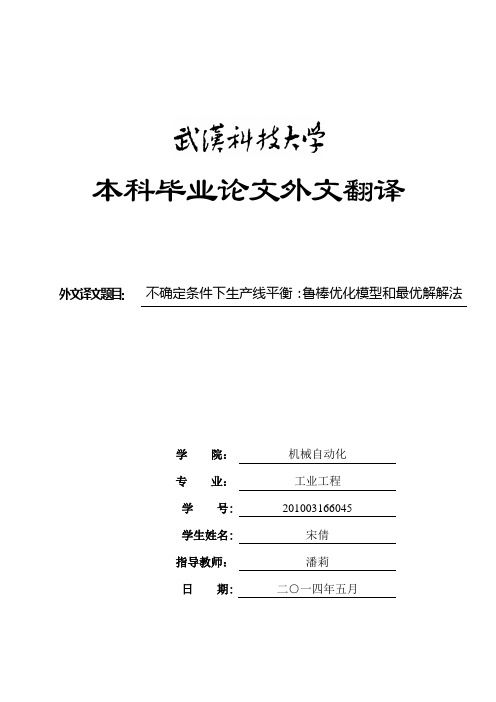
本科毕业论文外文翻译外文译文题目:不确定条件下生产线平衡:鲁棒优化模型和最优解解法学院:机械自动化专业:工业工程学号: 201003166045学生姓名: 宋倩指导教师:潘莉日期: 二○一四年五月Assembly line balancing under uncertainty: Robust optimization modelsand exact solution methodÖncü Hazır , Alexandre DolguiComputers &Industrial Engineering,2013,65:261–267不确定条件下生产线平衡:鲁棒优化模型和最优解解法安库·汉泽,亚历山大·多桂计算机与工业工程,2013,65:261–267摘要这项研究涉及在不确定条件下的生产线平衡,并提出两个鲁棒优化模型。
假设了不确定性区间运行的时间。
该方法提出了生成线设计方法,使其免受混乱的破坏。
基于分解的算法开发出来并与增强策略结合起来解决大规模优化实例.该算法的效率已被测试,实验结果也已经发表。
本文的理论贡献在于文中提出的模型和基于分解的精确算法的开发.另外,基于我们的算法设计出的基于不确定性整合的生产线的产出率会更高,因此也更具有实际意义。
此外,这是一个在装配线平衡问题上的开创性工作,并应该作为一个决策支持系统的基础。
关键字:装配线平衡;不确定性; 鲁棒优化;组合优化;精确算法1.简介装配线就是包括一系列在车间中进行连续操作的生产系统。
零部件依次向下移动直到完工。
它们通常被使用在高效地生产大量地标准件的工业行业之中。
在这方面,建模和解决生产线平衡问题也鉴于工业对于效率的追求变得日益重要。
生产线平衡处理的是分配作业到工作站来优化一些预定义的目标函数。
那些定义操作顺序的优先关系都是要被考虑的,同时也要对能力或基于成本的目标函数进行优化。
就生产(绍尔,1999)产品型号的数量来说,装配线可分为三类:单一模型(SALBP),混合模型(MALBP)和多模式(MMALBP)。
毕业论文外文翻译格式【范本模板】
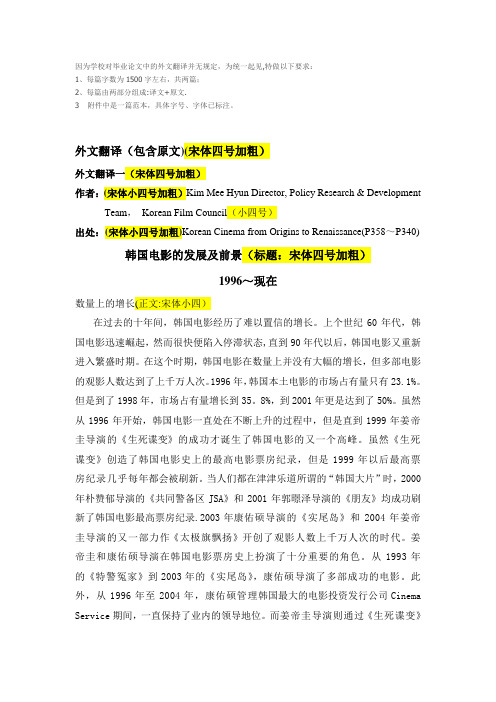
因为学校对毕业论文中的外文翻译并无规定,为统一起见,特做以下要求:1、每篇字数为1500字左右,共两篇;2、每篇由两部分组成:译文+原文.3 附件中是一篇范本,具体字号、字体已标注。
外文翻译(包含原文)(宋体四号加粗)外文翻译一(宋体四号加粗)作者:(宋体小四号加粗)Kim Mee Hyun Director, Policy Research & Development Team,Korean Film Council(小四号)出处:(宋体小四号加粗)Korean Cinema from Origins to Renaissance(P358~P340) 韩国电影的发展及前景(标题:宋体四号加粗)1996~现在数量上的增长(正文:宋体小四)在过去的十年间,韩国电影经历了难以置信的增长。
上个世纪60年代,韩国电影迅速崛起,然而很快便陷入停滞状态,直到90年代以后,韩国电影又重新进入繁盛时期。
在这个时期,韩国电影在数量上并没有大幅的增长,但多部电影的观影人数达到了上千万人次。
1996年,韩国本土电影的市场占有量只有23.1%。
但是到了1998年,市场占有量增长到35。
8%,到2001年更是达到了50%。
虽然从1996年开始,韩国电影一直处在不断上升的过程中,但是直到1999年姜帝圭导演的《生死谍变》的成功才诞生了韩国电影的又一个高峰。
虽然《生死谍变》创造了韩国电影史上的最高电影票房纪录,但是1999年以后最高票房纪录几乎每年都会被刷新。
当人们都在津津乐道所谓的“韩国大片”时,2000年朴赞郁导演的《共同警备区JSA》和2001年郭暻泽导演的《朋友》均成功刷新了韩国电影最高票房纪录.2003年康佑硕导演的《实尾岛》和2004年姜帝圭导演的又一部力作《太极旗飘扬》开创了观影人数上千万人次的时代。
姜帝圭和康佑硕导演在韩国电影票房史上扮演了十分重要的角色。
从1993年的《特警冤家》到2003年的《实尾岛》,康佑硕导演了多部成功的电影。
翻译格式模板

外文翻译(译文字数不少于2000字)齿叶夜睡莲对曼扎拉湖(尼罗河三角洲)周边栽培的水稻的生长及产量的化感作用*学生:×××指导老师:×××摘要:(黑体,小四)在埃及曼扎拉湖周边新开垦的与外界阻隔的湖田中,莲属侵入稻田是导致农作物破坏和谷粒产量下降的一个主要原因。
本研究针对齿叶夜睡莲对水稻的化感作用提出了深刻的见解(Oryza sativa cavr. Giza-177)。
莲根状茎的提取液对水稻种子萌发和幼苗的生长具有抑制作用。
抑制的程度主要是受提取液的类型和浓度的影响。
其中乙醇提取液和水提取液的抑制作用要比氯仿提取液的抑制作用强。
乙醇提取液中的酚醛含量显示了它的最大的抑制作用。
在一个目标作物(水稻)和它的近邻(莲)的盆载实验中,大米的干重和相对生长率受种子年龄和莲根状茎密度的影响,生长率随着莲密度的增大而降低。
对一个生长了莲和未生长莲的稻田中的数据处理证明了生长莲的稻田中水稻的叶面积指数和产量均降低。
通过气相色谱法或质谱分析法识别潜在的化感化合物显示了莲根状茎中存在化感化合物酚醛。
(宋体,小四)关键词:(黑体,小四)莲提取液,酚醛,萌发,幼苗,生长,叶面积指数,谷粒产量,水稻,埃及(宋体,小四)引言(大标题,黑体,四号)在过去的几十年里,尼罗河上大规模面积的湿地都因为各种各样的发展目的而被开垦。
曼扎拉湖的大部分面积也被开垦,并且倾向于当作农田使用。
因为高水位和水稻土,水稻是新开垦区域种植的主要农作物。
很多农田中都有记录大米的产量严重降低。
但是明显的全年的栽培大米和苜蓿并相互更替并不是导致大米产量严重降低的主要原因,其中还包括很多其它因素,但是它们的重要性*原文:Ahmad K. Hegazy, W. M.Amer, A. A. Khedr. Allelopathic effect of Nymphaea lotus L. on growth and yield of cultivated rice around Lake Manzala (Nile Delta). Hydrobiologia, 2001,464: 133–142.还没有完全理解;比如,差的排水系统和部分稻子的不可收割。
外文翻译规范要求及模版格式
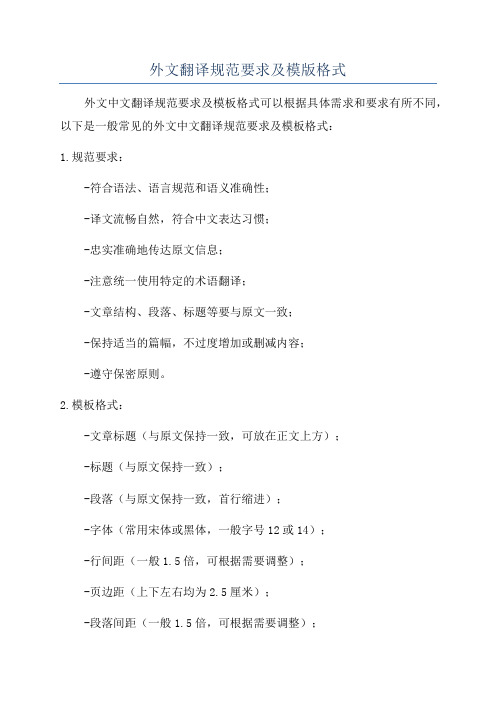
外文翻译规范要求及模版格式
外文中文翻译规范要求及模板格式可以根据具体需求和要求有所不同,以下是一般常见的外文中文翻译规范要求及模板格式:
1.规范要求:
-符合语法、语言规范和语义准确性;
-译文流畅自然,符合中文表达习惯;
-忠实准确地传达原文信息;
-注意统一使用特定的术语翻译;
-文章结构、段落、标题等要与原文一致;
-保持适当的篇幅,不过度增加或删减内容;
-遵守保密原则。
2.模板格式:
-文章标题(与原文保持一致,可放在正文上方);
-标题(与原文保持一致);
-段落(与原文保持一致,首行缩进);
-字体(常用宋体或黑体,一般字号12或14);
-行间距(一般1.5倍,可根据需要调整);
-页边距(上下左右均为2.5厘米);
-段落间距(一般1.5倍,可根据需要调整);
以上是一般常见的外文中文翻译规范要求及模板格式,具体要求和格式可以根据具体的翻译项目和要求进行调整。
在翻译过程中,保持准确、流畅、专业是非常重要的。
3外文翻译模板格式及要求

杭州电子科技大学毕业论文外文文献翻译要求根据《普通高等学校本科毕业设计(论文)指导》的内容,特对外文文献翻译提出以下要求:一、翻译的外文文献可以是一篇,也可以是两篇,但总字符要求不少于1.5万(或翻译成中文后至少在3000字以上)。
二、翻译的外文文献应主要选自学术期刊、学术会议的文章、有关著作及其他相关材料,应与毕业论文(设计)主题相关,并作为外文参考文献列入毕业论文(设计)的参考文献。
并在每篇中文译文首页用“脚注”形式注明原文作者及出处,中文译文后应附外文原文。
脚注的方法:插入----引用---脚注和尾注三、中文译文的基本撰写格式为:1.题目:采用小三号、黑体字、居中打印;2.正文:采用小四号、宋体字,行间距为固定值20磅,标准字符间距。
页边距为左3cm,右2.5cm,上下各2.5cm,页面统一采用A4纸。
英文原文如为word文档,请用罗马字体排版,段前空两格。
从正文开始编写页码,页码居中。
四、封面格式由学校统一制作(注:封面上的“翻译题目”指中文译文的题目),填充内容为加粗小三号楷体_GB2312,并按“封面、译文一、外文原文一、译文二、外文原文二、考核表”的顺序统一装订。
五、忌自行更改表格样式,学号请写完整。
封面和考核表均为一页纸张,勿换行换页。
毕业论文外文文献翻译毕业设计(论文)题目Xxx翻译(1)题目指翻译后的中文译文的题目翻译(2)题目指翻译后的中文译文的题目学院会计学院(以本模板为准)专业会计学(以本模板为准)姓名XXXXXX(以本模板为准)班级XX020811(以本模板为准)学号XX023101(以本模板为准)指导教师XXXXXX(以本模板为准)外文翻译考核表。
毕业设计(论文)外文资料和译文格式要求(模板)
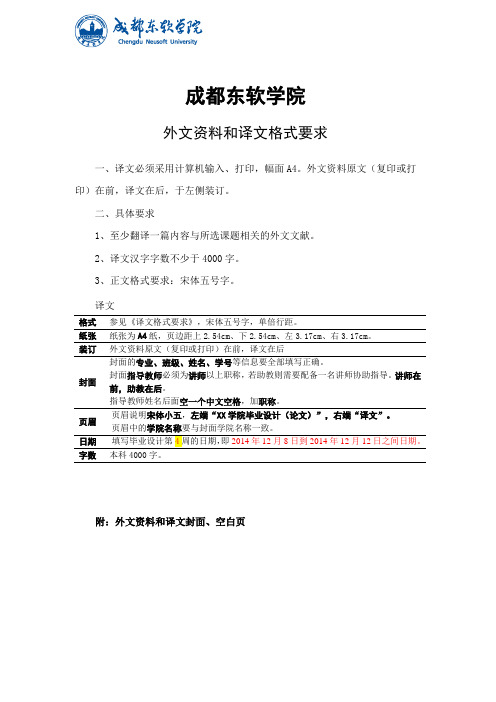
成都东软学院外文资料和译文格式要求一、译文必须采用计算机输入、打印,幅面A4。
外文资料原文(复印或打印)在前,译文在后,于左侧装订。
二、具体要求1、至少翻译一篇内容与所选课题相关的外文文献。
2、译文汉字字数不少于4000字。
3、正文格式要求:宋体五号字。
译文格式参见《译文格式要求》,宋体五号字,单倍行距。
纸张纸张为A4纸,页边距上2.54cm、下2.54cm、左3.17cm、右3.17cm。
装订外文资料原文(复印或打印)在前,译文在后封面封面的专业、班级、姓名、学号等信息要全部填写正确。
封面指导教师必须为讲师以上职称,若助教则需要配备一名讲师协助指导。
讲师在前,助教在后。
指导教师姓名后面空一个中文空格,加职称。
页眉页眉说明宋体小五,左端“XX学院毕业设计(论文)”,右端“译文”。
页眉中的学院名称要与封面学院名称一致。
字数本科4000字。
附:外文资料和译文封面、空白页成都东软学院外文资料和译文专业:软件工程移动互联网应用开发班级:2班姓名:罗荣昆学号:12310420216指导教师:2015年 12月 8日Android page layoutUsing XML-Based LayoutsW hile it is technically possible to create and attach widgets to our activity purely through Java code, the way we did in Chapter 4, the more common approach is to use an XML-based layout file. Dynamic instantiation of widgets is reserved for more complicated scenarios, where the widgets are not known at compile-time (e g., populating a column of radio buttons based on data retrieved off the Internet).With that in mind, it’s time to break out the XML and learn how to lay out Android activities that way.What Is an XML-Based Layout?As the name suggests, an XML-based layout is a specification of widgets’ relationships to each other—and to their containers (more on this in Chapter 7)—encoded in XML format. Specifi cally, Android considers XML-based layouts to be resources, and as such layout files are stored in the res/layout directory inside your Android project.Each XML file contains a tree of elements specifying a layout of widgets and their containers that make up one view hierarchy. The attributes of the XML elements are properties, describing how a widget should look or how a container should behave. For example, if a Button element has an attribute value of android:textStyle = "bold", that means that the text appearing on the face of the button should be rendered in a boldface font style.Android’s SDK ships with a tool (aapt) which uses the layouts. This tool should be automatically invoked by your Android tool chain (e.g., Eclipse, Ant’s build.xml). Of particular importance to you as a developer is that aapt generates the R.java source file within your project, allowing you to access layouts and widgets within those layouts directly from your Java code. Why Use XML-Based Layouts?Most everything you do using XML layout files can be achieved through Java code. For example, you could use setTypeface() to have a button render its textin bold, instead of using a property in an XML layout. Since XML layouts are yet another file for you to keep track of, we need good reasons for using such files.Perhaps the biggest reason is to assist in the creation of tools for view definition, such as a GUI builder in an IDE like Eclipse or a dedicated Android GUI designer like DroidDraw1. Such GUI builders could, in principle, generate Java code instead of XML. The challenge is re-reading the UI definition to support edits—that is far simpler if the data is in a structured format like XML than in a programming language. Moreover, keeping generated XML definitions separated from hand-written Java code makes it less likely that somebody’s custom-crafted source will get clobbered by accident when the generated bits get re-generated. XML forms a nice middle ground between something that is easy for tool-writers to use and easy for programmers to work with by hand as needed.Also, XML as a GUI definition format is becoming more commonplace. Microsoft’s XAML2, Adobe’s Flex3, and Mozilla’s XUL4 all take a similar approach to that of Android: put layout details in an XML file and put programming smarts in source files (e.g., JavaScript for XUL). Many less-well-known GUI frameworks, such as ZK5, also use XML for view definition. While “following the herd” is not necessarily the best policy, it does have the advantage of helping to ease the transition into Android from any other XML-centered view description language. OK, So What Does It Look Like?Here is the Button from the previous chapter’s sample application, converted into an XMLlayout file, found in the Layouts/NowRedux sample project. This code sample along with all others in this chapter can be found in the Source Code area of .<?xml version="1.0" encoding="utf-8"?><Button xmlns:android="/apk/res/android"android:id="@+id/button"android:text=""android:layout_width="fill_parent"android:layout_height="fill_parent"/>The class name of the widget—Button—forms the name of the XML element. Since Button is an Android-supplied widget, we can just use the bare class name. If you create your own widgets as subclasses of android.view.View, you would need to provide a full package declara tion as well.The root element needs to declare the Android XML namespace:xmlns:android="/apk/res/android"All other elements will be children of the root and will inherit that namespace declaration.Because we want to reference this button from our Java code, we need to give it an identifier via the android:id attribute. We will cover this concept in greater detail later in this chapter.The remaining attributes are properties of this Button instance:• android:text indicates the initial text to be displayed on the button face (in this case, an empty string)• android:layout_width and android:layout_height tell Android to have the button’swidth and height fill the “parent”, in this case the entire screen—these attributes will be covered in greater detail in Chapter 7.Since this single widget is the only content in our activity, we only need this single element. Complex UIs will require a whole tree of elements, representing the widgets and containers that control their positioning. All the remaining chapters of this book will use the XML layout form whenever practical, so there are dozens of other examples of more complex layouts for you to peruse from Chapter 7 onward.What’s with the @ Signs?Many widgets and containers only need to appear in the XML layout file and do not need to be referenced in your Java code. For example, a static label (TextView) frequently only needs to be in the layout file to indicate where it should appear. These sorts of elements in the XML file do not need to have the android:id attribute to give them a name.Anything you do want to use in your Java source, though, needs an android:id.The convention is to use @+id/... as the id value, where the ... represents your locally unique name for the widget in question. In the XML layout example in the preceding section, @+id/button is the identifier for the Button widget.Android provides a few special android:id values, of the form @android:id/.... We will see some of these in various chapters of this book, such as Chapters 8 and 10.We Attach These to the Java How?Given that you have painstakingly set up the widgets and containers in an XML layout filenamed main.xml stored in res/layout, all you need is one statement in your activity’s onCreate() callback to use that layout:setContentView(yout.main);This is the same setContentView() we used earlier, passing it an instance of a View subclass (in that case, a Button). The Android-built view, constructed from our layout, is accessed from that code-generated R class. All of the layouts are accessible under yout, keyed by the base name of the layout file—main.xml results in yout.main.To access our identified widgets, use findViewById(), passing in the numeric identifier of the widget in question. That numeric identifier was generated by Android in the R class asR.id.something (where something is the specific widget you are seeking). Those widgets are simply subclasses of View, just like the Button instance we created in Chapter 4.The Rest of the StoryIn the original Now demo, the button’s face would show the current time, which would reflect when the button was last pushed (or when the activity was first shown, if the button had not yet been pushed).Most of that logic still works, even in this revised demo (NowRedux). However,rather than instantiating the Button in our activity’s onCreate() callback, we can reference the one from the XML layout:package youts;import android.app.Activity;import android.os.Bundle;import android.view.View;import android.widget.Button; import java.util.Date;public class NowRedux extends Activity implements View.OnClickListener { Button btn;@Overridepublic void onCreate(Bundle icicle) { super.onCreate(icicle);setContentView(yout.main);btn=(Button)findViewById(R.id.button);btn.setOnClickListener(this);upd ateTime();}public void onClick(View view) { updateTime();}private void updateTime() {btn.setText(new Date().toString()); }}The first difference is that rather than setting the content view to be a view we created in Java code, we set it to reference the XML layout (setContentView(yout.main)). The R.java source file will be updated when we rebuild this project to include a reference to our layout file (stored as main.xml in our project’s res/l ayout directory).The other difference is that we need to get our hands on our Button instance, for which we use the findViewById() call. Since we identified our button as @+id/button, we can reference the button’s identifier as R.id.button. Now, with the Button instance in hand, we can set the callback and set the label as needed.As you can see in Figure 5-1, the results look the same as with the originalNow demo.Figure 5-1. The NowRedux sample activity Employing Basic WidgetsE very GUI toolkit has some basic widgets: fields, labels, buttons, etc. Android’s toolkit is no different in scope, and the basic widgets will provide a good introduction as to how widgets work in Android activities.Assigning LabelsThe simplest widget is the label, referred to in Android as a TextView. Like in most GUI toolkits, labels are bits of text not editable directly by users. Typically, they are used to identify adjacent widgets (e.g., a “Name:” label before a field where one fills in a name).In Java, you can create a label by creating a TextView instance. More commonly, though, you will create labels in XML layout files by adding a TextView element to the layout, with an android:text property to set the value of the label itself. If you need to swap labels based on certain criteria, such as internationalization, you may wish to use a resource reference in the XML instead, as will be described in Chapter 9. TextView has numerous other properties of relevance for labels, such as:• android:typeface to set the typeface to use for the label (e.g., monospace) • android:textStyle to indicate that the typeface should be made bold (bold), italic (italic),or bold and italic (bold_italic)• android:textColor to set the color of the label’s text, in RGB hex format (e.g., #FF0000 for red)For example, in the Basic/Label project, you will find the following layout file:<?xml version="1.0" encoding="utf-8"?><TextView xmlns:android=/apk/res/androidandroid:layout_width="fill_parent"android:layout_height="wrap_content"android:text="You were expecting something profound?" />As you can see in Figure 6-1, just that layout alone, with the stub Java source provided by Android’s p roject builder (e.g., activityCreator), gives you the application.Figure 6-1. The LabelDemo sample applicationButton, Button, Who’s Got the Button?We’ve already seen the use of the Button widget in Chapters 4 and 5. As it turns out, Button is a subclass of TextView, so everything discussed in the preceding section in terms of formatting the face of the button still holds. Fleeting ImagesAndroid has two widgets to help you embed images in your activities: ImageView and ImageButton. As the names suggest, they are image-based analogues to TextView and Button, respectively.Each widget takes an android:src attribute (in an XML layout) to specify what picture to use. These usually reference a drawable resource, described in greater detail in the chapter on resources. You can also set the image content based on a Uri from a content provider via setImageURI().ImageButton, a subclass of ImageView, mixes in the standard Button behaviors, for responding to clicks and whatnot.For example, take a peek at the main.xml layout from the Basic/ImageView sample project which is found along with all other code samples at : <?xml version="1.0" encoding="utf-8"?><ImageView xmlns:android=/apk/res/androidandroid:id="@+id/icon"android:layout_width="fill_parent"android:layout_height="fill_parent"android:adjustViewBounds="true"android:src="@drawable/molecule" />The result, just using the code-generated activity, is shown in Figure 6-2.Figure 6-2. The ImageViewDemo sample applicationFields of Green. Or Other Colors.Along with buttons and labels, fields are the third “anchor” of most GUI toolkits. In Android, they are implemented via the EditText widget, which is a subclass of the TextView used for labels.Along with the standard TextView properties (e.g., android:textStyle), EditText has many others that will be useful for you in constructing fields, including:• android:autoText, to control if the fie ld should provide automatic spelling assistance• android:capitalize, to control if the field should automatically capitalize the first letter of entered text (e.g., first name, city) • android:digits, to configure the field to accept only certain digi ts • android:singleLine, to control if the field is for single-line input or multiple-line input (e.g., does <Enter> move you to the next widget or add a newline?)Beyond those, you can configure fields to use specialized input methods, such asandroid:numeric for numeric-only input, android:password for shrouded password input,and android:phoneNumber for entering in phone numbers. If you want to create your own input method scheme (e.g., postal codes, Social Security numbers), you need to create your own implementation of the InputMethod interface, then configure the field to use it via android: inputMethod.For example, from the Basic/Field project, here is an XML layout file showing an EditText:<?xml version="1.0" encoding="utf-8"?><EditTextxmlns:android=/apk/res/androidandroid:id="@+id/field"android:layout_width="fill_parent"android:layout_height="fill_parent"android:singleLine="false" />Note that android:singleLine is false, so users will be able to enter in several lines of text. For this project, the FieldDemo.java file populates the input field with some prose:package monsware.android.basic;import android.app.Activity;import android.os.Bundle;import android.widget.EditText;public class FieldDemo extends Activity { @Overridepublic void onCreate(Bundle icicle) { super.onCreate(icicle);setContentView(yout.main);EditText fld=(EditText)findViewById(R.id.field);fld.setText("Licensed under the Apache License, Version 2.0 " + "(the \"License\"); you may not use this file " + "except in compliance with the License. You may " + "obtain a copy of the License at " +"/licenses/LICENSE-2.0");}}The result, once built and installed into the emulator, is shown in Figure 6-3.Figure 6-3. The FieldDemo sample applicationNote Android’s emulator only allows one application in the launcher per unique Java package. Since all the demos in this chapter share the monsware.android.basic package, you will only see one of these demos in your emulator’s launcher at any one time.Another flavor of field is one that offers auto-completion, to help users supply a value without typing in the whole text. That is provided in Android as the AutoCompleteTextView widget and is discussed in Chapter 8.Just Another Box to CheckThe classic checkbox has two states: checked and unchecked. Clicking the checkbox toggles between those states to indicate a choice (e.g., “Ad d rush delivery to my order”). In Android, there is a CheckBox widget to meet this need. It has TextView as an ancestor, so you can use TextView properties likeandroid:textColor to format the widget. Within Java, you can invoke: • isChecked() to determi ne if the checkbox has been checked• setChecked() to force the checkbox into a checked or unchecked state • toggle() to toggle the checkbox as if the user checked itAlso, you can register a listener object (in this case, an instance of OnCheckedChangeListener) to be notified when the state of the checkbox changes.For example, from the Basic/CheckBox project, here is a simple checkbox layout:<?xml version="1.0" encoding="utf-8"?><CheckBox xmlns:android="/apk/res/android"android:id="@+id/check"android:layout_width="wrap_content"android:layout_height="wrap_content"android:text="This checkbox is: unchecked" />The corresponding CheckBoxDemo.java retrieves and configures the behavior of the checkbox:public class CheckBoxDemo extends Activityimplements CompoundButton.OnCheckedChangeListener { CheckBox cb;@Overridepublic void onCreate(Bundle icicle) { super.onCreate(icicle);setContentView(yout.main);cb=(CheckBox)findViewById(R.id.check);cb.setOnCheckedChangeListener(this);}public void onCheckedChanged(CompoundButton buttonView,boolean isChecked) {if (isChecked) {cb.setText("This checkbox is: checked");}else {cb.setText("This checkbox is: unchecked");}}}Note that the activity serves as its own listener for checkbox state changes since it imple ments the OnCheckedChangeListener interface (via cb.setOnCheckedChangeListener(this)). The callback for the listener is onCheckedChanged(), which receives the checkbox whose state has changed and what the new state is. In this case, we update the text of the checkbox to reflect what the actual box contains.The result? Clicking the checkbox immediately updates its text, as you can see in Figures 6-4 and 6-5.Figure 6-4. The CheckBoxDemo sample application, with the checkbox uncheckedFigure 6-5. The same application, now with the checkbox checkedTurn the Radio UpAs with other implementations of radio buttons in other toolkits, Android’s radio buttons are two-state, like checkboxes, but can be grouped such that only one radio button in the group can be checked at any time.Like CheckBox, RadioButton inherits from CompoundButton, which in turn inherits fromTextView. Hence, all the standard TextView properties for font face, style, color, etc., are available for controlling the look of radio buttons. Similarly, you can call isChecked() on a RadioButton to see if it is selected, toggle() to select it, and so on, like you can with a CheckBox.Most times, you will want to put your RadioButton widgets inside of aRadioGroup. The RadioGroup indicates a set of radio buttons whose state is tied, meaning only one button out of the group can be selected at any time. If you assign an android:id to your RadioGroup in your XML layout, you can access the group from your Java code and invoke:• check() to check a specific radio button via its ID (e.g., group.check(R.id.radio1))• clearCheck() to clear all radio buttons, so none in the group are checked• getCheckedRadioButtonId() to get the ID of the currently-checked radio button (or -1 if none are checked)For example, from the Basic/RadioButton sample application, here is an XML layout showing a RadioGroup wrapping a set of RadioButton widgets: <?xml version="1.0" encoding="utf-8"?> <RadioGroupxmlns:android=/apk/res/androidandroid:orientation="vertical"android:layout_width="fill_parent"android:layout_height="fill_parent" ><RadioButton android:id="@+id/radio1"android:layout_width="wrap_content"android:layout_height="wrap_content"android:text="Rock" /><RadioButton android:id="@+id/radio2"android:layout_width="wrap_content"android:layout_height="wrap_content"android:text="Scissors" /><RadioButton android:id="@+id/radio3"android:layout_width="wrap_content"android:layout_height="wrap_content"android:text="Paper" /></RadioGroup>Figure 6-6 shows the result using the stock Android-generated Java forthe project and this layout.Figure 6-6. The RadioButtonDemo sample application Note that the radio button group is initially set to be completely unchecked at the outset. To pre-set one of the radio buttons to be checked, use either setChecked() on the RadioButton or check() on the RadioGroup from within your onCreate() callback in your activity.It’s Quite a ViewAll widgets, including the ones previously shown, extend View, and as such give all widgets an array of useful properties and methods beyond those already described.Useful PropertiesSome of the properties on View most likely to be used include:• Controls the focus sequence:• android:nextFocusDown• android:nextFocusLeft• android:nextFocusRight• android:nextFocusUp• android:visibility, which controls wheth er the widget is initially visible• android:background, which typically provides an RGB color value (e.g., #00FF00 for green) to serve as the background for the widgetUseful MethodsYou can toggle whether or not a widget is enabled via setEnabled() and see if it is enabled via isEnabled(). One common use pattern for this is to disable some widgets based on a CheckBox or RadioButton selection.You can give a widget focus via requestFocus() and see if it is focused via isFocused(). You might use this in concert with disabling widgets as previously mentioned, to ensure the proper widget has the focus once your disabling operation is complete.To help navigate the tree of widgets and containers that make up an activity’s overall view, you can use:• get Parent() to find the parent widget or container• findViewById() to find a child widget with a certain ID• getRootView() to get the root of the tree (e.g., what you provided to the activity via setContentView())Android 页面布局使用XML进行布局虽然纯粹通过Java代码在activity上创建和添加部件,在技术上是可行的,我们在第4章中做的一样,更常见的方法是使用一种基于XML的布局文件。
钢筋混凝土中英文对照外文翻译文献

中英文资料对照外文翻译目录1 中文翻译 (1)1.1钢筋混凝土 (1)1.2土方工程 (2)1.3结构的安全度 (3)2 外文翻译 (6)2.1 Reinforced Concrete (6)2.2 Earthwork (7)2.3 Safety of Structures (9)1 中文翻译1.1钢筋混凝土素混凝土是由水泥、水、细骨料、粗骨料(碎石或;卵石)、空气,通常还有其他外加剂等经过凝固硬化而成。
将可塑的混凝土拌合物注入到模板内,并将其捣实,然后进行养护,以加速水泥与水的水化反应,最后获得硬化的混凝土。
其最终制成品具有较高的抗压强度和较低的抗拉强度。
其抗拉强度约为抗压强度的十分之一。
因此,截面的受拉区必须配置抗拉钢筋和抗剪钢筋以增加钢筋混凝土构件中较弱的受拉区的强度。
由于钢筋混凝土截面在均质性上与标准的木材或钢的截面存在着差异,因此,需要对结构设计的基本原理进行修改。
将钢筋混凝土这种非均质截面的两种组成部分按一定比例适当布置,可以最好的利用这两种材料。
这一要求是可以达到的。
因混凝土由配料搅拌成湿拌合物,经过振捣并凝固硬化,可以做成任何一种需要的形状。
如果拌制混凝土的各种材料配合比恰当,则混凝土制成品的强度较高,经久耐用,配置钢筋后,可以作为任何结构体系的主要构件。
浇筑混凝土所需要的技术取决于即将浇筑的构件类型,诸如:柱、梁、墙、板、基础,大体积混凝土水坝或者继续延长已浇筑完毕并且已经凝固的混凝土等。
对于梁、柱、墙等构件,当模板清理干净后应该在其上涂油,钢筋表面的锈及其他有害物质也应该被清除干净。
浇筑基础前,应将坑底土夯实并用水浸湿6英寸,以免土壤从新浇的混凝土中吸收水分。
一般情况下,除使用混凝土泵浇筑外,混凝土都应在水平方向分层浇筑,并使用插入式或表面式高频电动振捣器捣实。
必须记住,过分的振捣将导致骨料离析和混凝土泌浆等现象,因而是有害的。
水泥的水化作用发生在有水分存在,而且气温在50°F以上的条件下。
外文翻译模板

半鞅最大不等式和强大数定律(4号黑体加粗.居中)(5号 空一行)Tasos C.Christofides (Times New Roman5号,居中)(5号 空一行)摘要:Newman 和Wright(Z.Wahrsch.V erw.Geb.59(1982)361-371)首次将Chow 最大不等式从(局部)鞅的情况推广到半(局部)鞅的情况。
这个结论可以作为证明其他不等式如Hajek-Renyi 不等式和Doob 最大不等式的“资源”的不等式,并且由此得出了强大数定律。
数学期望值为零的联合随机变量的部分和是半鞅。
因此,最大不等式和强大数定律在情况被运用联合随机变量中有特殊的运用。
关键词:半鞅;联合随机变量1.前言定义1.1 设1S ,2S , 是1L 上的随机变量数列。
假设当1,2,j = 时,有11{()(,,)}0j j j E S S f S S +-≥ (1.1)对于所有并列方式且单调不减的函数f 它们的数学期望是可以定义的。
于是,称数列1{}j j S ≥为半鞅。
在此基础上,如果函数f 是非负的,那么数列1{}j j S ≥称为半局部鞅。
备注:如果函数f 不要求是单调不减的那么满足(1.1)的条件与是满足1{}j j S ≥是σ数域上的鞅的条件是等价的。
类似地,如果假定f 是非负的且不一定是单调不减的,那么满足(1.1)的条件与满足1{}j j S ≥是局部鞅的条件是等价的。
定义1.1应归功于Newman 和Wright(1982)。
在以前的备注中指出过半鞅和鞅之间的联系,该联系提出了这样的一个问题:某些结论尤其是最大不等式在鞅中是有效的,那么在半鞅中是否仍然有效。
Newman 和Wright (1982)已经推广了变量的结论,结论中包括将Doob 最大不等式和Doob 递增不等式推广到半鞅的情况。
与半鞅的概念相应的是绝对依赖的概念。
最后,我们得到下面的定义。
定义1.2 有限个随机变量是联合变量如果11{(,,),(,,)}0m m C ov f X X g X X ≥对于在m R 上任意两个并列方式且单调不减函数f ,g 而言,协方差被定义。
外文文献翻译译稿和原文【范本模板】
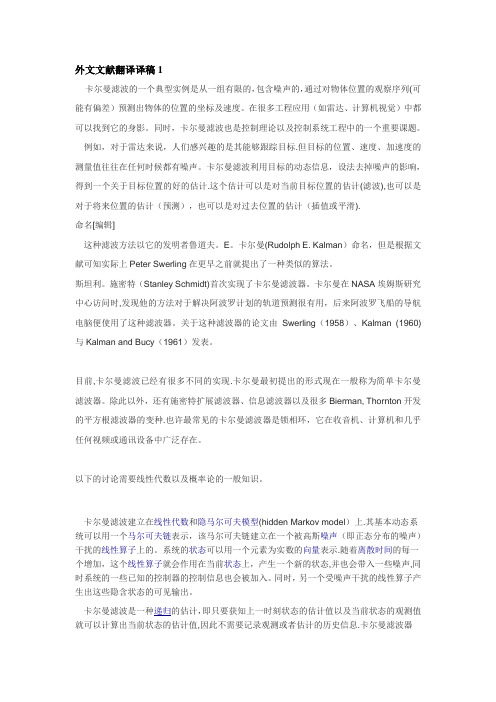
外文文献翻译译稿1卡尔曼滤波的一个典型实例是从一组有限的,包含噪声的,通过对物体位置的观察序列(可能有偏差)预测出物体的位置的坐标及速度。
在很多工程应用(如雷达、计算机视觉)中都可以找到它的身影。
同时,卡尔曼滤波也是控制理论以及控制系统工程中的一个重要课题。
例如,对于雷达来说,人们感兴趣的是其能够跟踪目标.但目标的位置、速度、加速度的测量值往往在任何时候都有噪声。
卡尔曼滤波利用目标的动态信息,设法去掉噪声的影响,得到一个关于目标位置的好的估计.这个估计可以是对当前目标位置的估计(滤波),也可以是对于将来位置的估计(预测),也可以是对过去位置的估计(插值或平滑).命名[编辑]这种滤波方法以它的发明者鲁道夫。
E。
卡尔曼(Rudolph E. Kalman)命名,但是根据文献可知实际上Peter Swerling在更早之前就提出了一种类似的算法。
斯坦利。
施密特(Stanley Schmidt)首次实现了卡尔曼滤波器。
卡尔曼在NASA埃姆斯研究中心访问时,发现他的方法对于解决阿波罗计划的轨道预测很有用,后来阿波罗飞船的导航电脑便使用了这种滤波器。
关于这种滤波器的论文由Swerling(1958)、Kalman (1960)与Kalman and Bucy(1961)发表。
目前,卡尔曼滤波已经有很多不同的实现.卡尔曼最初提出的形式现在一般称为简单卡尔曼滤波器。
除此以外,还有施密特扩展滤波器、信息滤波器以及很多Bierman, Thornton开发的平方根滤波器的变种.也许最常见的卡尔曼滤波器是锁相环,它在收音机、计算机和几乎任何视频或通讯设备中广泛存在。
以下的讨论需要线性代数以及概率论的一般知识。
卡尔曼滤波建立在线性代数和隐马尔可夫模型(hidden Markov model)上.其基本动态系统可以用一个马尔可夫链表示,该马尔可夫链建立在一个被高斯噪声(即正态分布的噪声)干扰的线性算子上的。
系统的状态可以用一个元素为实数的向量表示.随着离散时间的每一个增加,这个线性算子就会作用在当前状态上,产生一个新的状态,并也会带入一些噪声,同时系统的一些已知的控制器的控制信息也会被加入。
外文翻译常见问题

外文翻译常见问题
1)翻译内容范围:
题目,作者,摘要,关键字,正文部分(通常包括主要内容部分以及结论、实验结果、致谢等,作者信息以及参考文献不用翻译,也没必要拷贝至中文翻译里)
2)格式
翻译首页严格按照学校要求填写,学生个人信息(学院、学号,姓名等),外文出处部分应包含文章题目,杂志名称以及文章的起止页码信息,并注意此页面的规范和美观。
中文翻译译文中,首行应为“附件1:外文资料翻译译文”,注意字体字号,按模板格式。
行间距可以用1.25或1.5倍行间距均可。
段落等参考外文原文进行分段。
各级标题应该用黑体或宋体加粗来醒目表示。
3)翻译部分图表
文章涉及的图或表,最好用图片格式剪切下来,粘贴到文中相应的位置(注意写清图号和图名等,图片大小适中,不宜过大)。
注意图片版式选择“嵌入型”,不要用“四周型”或其他类型。
公式和图表要求居中。
4)注意
严格禁止完全用软件进行翻译,如借助软件翻译,必须自己再将译文与
原文逐句对照校对两遍,达到语句通顺,语义明确的程度。
5)外文原文要求
如为pdf或其他原文版面格式的文件,将其直接打印到A4的纸上即可,不用将外文拷贝到word中进行打印,然后附在中文翻译的后面即可。
外文文献翻译译文【范本模板】

在激光作用下核压力容器钢焊接接头的显微组织和力学性能摘要:设计间接热冲压工艺,利用有限元法对零件的几何尺寸和力学性能进行了预测.在间接热冲压过程的情况下,生产性能与适应车身部件,冷却路径造成扩散和扩散控制的相变。
通过人脸的相变引起的体积膨胀为面心立方(FCC)为体心立方(BCC)和体心四方(BCT)马氏体的形成导致相变诱导株的整体应力热冲压的车身部件的计算是很重要的。
计算的应力和应变状态正确,它是必要的模型的扩散和扩散控制的相变现象,考虑到间接热冲压过程的边界条件。
现有的材料模型进行分析和扩展以提高计算铁氧体、珍珠岩的数量和分布,其预测的准确性,整个退火过程中贝氏体和马氏体.工业用新方法在有限元程序LS-DYNA 971实现关键词:核钢稳压器压水反应堆反应堆压力容器结构完整性焊接韧性SA508钢通常用于民用核反应堆的关键部件,如反应堆压力容器。
核部件通常采用电弧焊接工艺,但与设计为未来的新建设项目超过60年的生活,新的焊接技术正在寻求.在这种探索性的研究,为第一时间,自体激光焊接6毫米厚的进行SA508 Cl。
3钢板使用16千瓦激光系统在4千瓦的功率运行。
这个显微组织和力学性能(包括显微硬度、抗拉强度、延伸率等夏比冲击韧性)的特点和结构进行了比较电弧焊接.基于移动体热的三维瞬态模型源模型也发展到模拟激光焊接热循环,以估计冷却速率的过程。
初步结果表明,激光焊接工艺可以无宏观缺陷的焊缝,激光焊接的强度和韧性在这项研究中的联合,得到的值,在焊接的母材条件。
反应堆压力容器的寿命和安全运行(RPV),这是核电站中最关键的部件之一.取决于高温压力容器材料的耐久性,高压力和放射性环境.具有较高强度,韧性和抗辐照脆化的材料的需要是上升的,由于增加的发电容量和核电厂的设计寿命[1 ],[ 2 ],[ 3 ],[ 4 ],[ 5 ],[7 ],[8 ]和[ 6 ].SA508钢已经用于许多RPV?的压水反应堆制造因为他们提供的结合强度,延展性好,断裂韧性,相对于机械性能的均匀性,和他们的经济[9 ]、[ 10 ]、[ 11 ]和[12 ].无人机是采用焊接厚环形锻件或SA508钢板在一起。
3-外文翻译模板
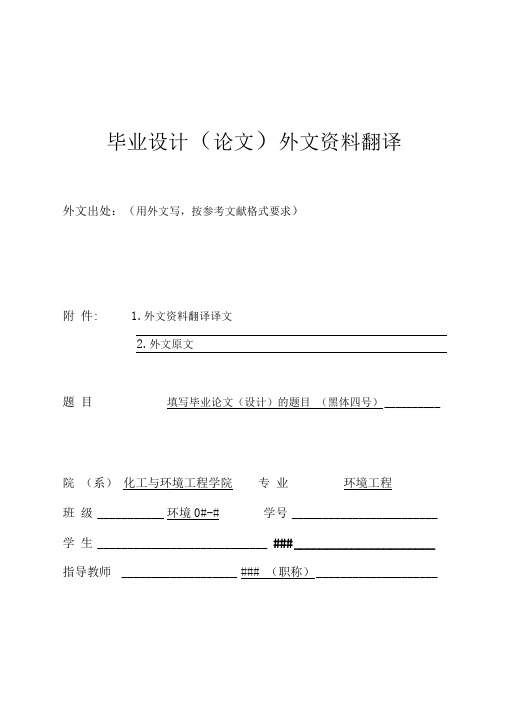
说明: 模板中的蓝色字体及红色字体为提示说明用,填写过程应删除。
3外文翻译模板外文翻译格式毕业论文外文翻译格式外文翻译外文翻译网站外文翻译范文外文文献翻译外文翻译怎么写谷歌翻译身份证翻译模板
毕业设计
外文出处:(用外文写,按参考文献格式要求)
附 件:1.外文资料翻译译文
2.外文原文
题 目填写毕业论文(设计)的题目 (黑体四号)
院 (系)化工与环境工程学院专 业环境工程
班 级环境0#Байду номын сангаас#学号
学 生###
指导教师###(职称)
附件1:外文资料翻译译文
译文标题 (3号黑体,居中)
(空一行)
xxxxxxxxxxxxxxxxxxxxxxxxxxxxxxxxxxxxxxxxxxxxxxxxxxxxxxxxxxxxxxx
xxxx。…(小4号宋体,1.25倍行距)
附件2:外文原文
外文文献翻译(最终版)【范本模板】
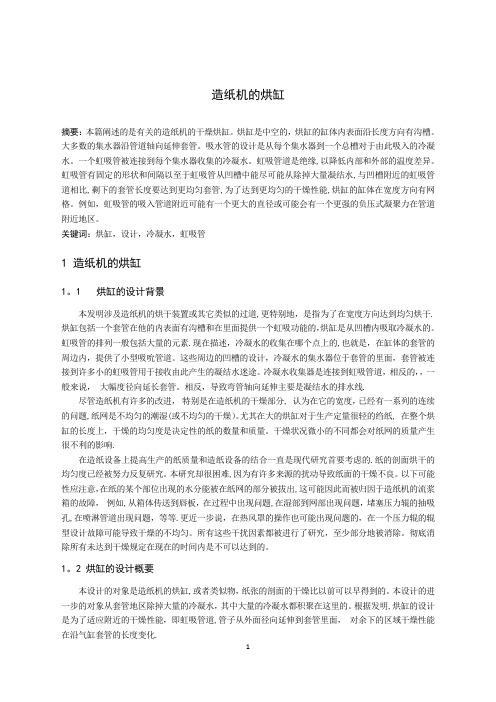
造纸机的烘缸摘要:本篇阐述的是有关的造纸机的干燥烘缸。
烘缸是中空的,烘缸的缸体内表面沿长度方向有沟槽。
大多数的集水器沿管道轴向延伸套管。
吸水管的设计是从每个集水器到一个总槽对于由此吸入的冷凝水。
一个虹吸管被连接到每个集水器收集的冷凝水。
虹吸管道是绝缘,以降低内部和外部的温度差异。
虹吸管有固定的形状和间隔以至于虹吸管从凹槽中能尽可能从除掉大量凝结水,与凹槽附近的虹吸管道相比,剩下的套管长度要达到更均匀套管,为了达到更均匀的干燥性能,烘缸的缸体在宽度方向有网格。
例如,虹吸管的吸入管道附近可能有一个更大的直径或可能会有一个更强的负压式凝聚力在管道附近地区。
关键词:烘缸,设计,冷凝水,虹吸管1 造纸机的烘缸1。
1 烘缸的设计背景本发明涉及造纸机的烘干装置或其它类似的过道,更特别地,是指为了在宽度方向达到均匀烘干.烘缸包括一个套管在他的内表面有沟槽和在里面提供一个虹吸功能的,烘缸是从凹槽内吸取冷凝水的。
虹吸管的排列一般包括大量的元素.现在描述,冷凝水的收集在哪个点上的,也就是,在缸体的套管的周边内,提供了小型吸吮管道。
这些周边的凹槽的设计,冷凝水的集水器位于套管的里面,套管被连接到许多小的虹吸管用于接收由此产生的凝结水迷途。
冷凝水收集器是连接到虹吸管道,相反的,,一般来说,大幅度径向延长套管。
相反,导致弯管轴向延伸主要是凝结水的排水线.尽管造纸机有许多的改进,特别是在造纸机的干燥部分, 认为在它的宽度,已经有一系列的连续的问题,纸网是不均匀的潮湿(或不均匀的干燥)。
尤其在大的烘缸对于生产定量很轻的绉纸, 在整个烘缸的长度上,干燥的均匀度是决定性的纸的数量和质量。
干燥状况微小的不同都会对纸网的质量产生很不利的影响.在造纸设备上提高生产的纸质量和造纸设备的结合一直是现代研究首要考虑的.纸的剖面烘干的均匀度已经被努力反复研究。
本研究却很困难,因为有许多来源的扰动导致纸面的干燥不良。
以下可能性应注意,在纸的某个部位出现的水分能被在纸网的部分被拔出,这可能因此而被归因于造纸机的流浆箱的故障,例如,从箱体传送到唇板,在过程中出现问题,在湿部到网部出现问题,堵塞压力辊的抽吸孔,在喷淋管道出现问题,等等.更近一步说,在热风罩的操作也可能出现问题的,在一个压力辊的辊型设计故障可能导致干燥的不均匀。
外文翻译原文模板

1、外文资料翻译内容要求:外文资料的内容应为本学科研究领域,并与毕业设计(论文)选题相关的技术资料或专业文献,译文字数应不少于3000汉字以上,同时应在译文末注明原文的出处。
不可采用网络中直接有外文和原文的。
2、外文资料翻译格式要求:译文题目采用小二号黑体,居中;译文正文采用宋体小四号,段前、段后距为0行;行距:固定值20磅。
英文原文如果为打印的话用新罗马(Times New Roman)小四号字。
装订时原文在前,译文在后。
文章中有引用的地方在原文中也要体现。
参考文献也要翻译成中文!An Energy-Efficient Cooperative Algorithm for Data Estimation inWireless Sensor NetworksAbstract – In Wireless Sensor Networks (WSN), nodes operate on batteries and network’s lifetime depends on energy consumption of the nodes. Consider the class of sensor networks where all nodes sense a single phenomenon at different locations and send messages to a Fusion Center (FC) in order to estimate the actual information. In classical systems all data processing tasks are done in the FC and there is no processing or compression before transmission. In the proposed algorithm, network is divided into clusters and data processing is done in two parts. The first part is performed in each cluster at the sensor nodes after local data sharing and the second part will be done at the Fusion Center after receiving all messages from clusters. Local data sharing results in more efficient data transmission in terms of number of bits. We also take advantage of having the same copy of data at all nodes of each cluster and suggest a virtual Multiple-Input Multiple-Output (V-MIMO) architecture for data transmission from clusters to the FC. A Virtual-MIMO network is a set of distributed nodes each having one antenna. By sharing their data among themselves, these nodes turn into a classical MIMO system. In the previously proposed cooperative/virtual MIMO architectures there has not been any data processing or compression in the conference phase. We modify the existing VMIMO algorithms to suit the specific class of sensor networks that is of our concern. We use orthogonal Space-Time Block Codes (STBC) for MIMO part and by simulation show that this algorithm saves considerable energy compared to classical systems.I. INTRODUCTIONA typical Wireless Sensor Network consists of a set of small, low-cost and energy-limited sensor nodes which are deployed in a field in order to observe a phenomenon and transmit it to a Fusion Center (FC). These sensors are deployed close to one another and their readings of the environment are highly correlated. Their objective is to report a descriptive behavior of the environment based on all measurements to the Fusion Center. This diversity in measurement lets the system become more reliable and robust against failure. In general, each node is equipped with a sensing device, a processor and a communication module (which can be either a transmitter or transmitter/receiver).Sensor nodes are equipped with batteries and are supposed to work for a long period of time without battery replacement. Thus, they are limited in energy and one of the most important issues in designing sensor networks will be the energy consumption of the sensor nodes. To deal with this problem, we might either reduce the number of bits to be transmitted by source compression or reduce the required power for transmission by applying advanced transmission techniques while satisfying certain performance requirement.A lot of research has been done in order to take advantage of the correlation among sensors’ data for reducing the number of bits to be transmitted. Some are based on distributed source coding[1]while others use decentralized estimation[2-5]. In [1], authors present an efficient algorithm that applies distributed compression based on Slepian – Wolf[14] encoding technique and use an adaptive signal processing algorithm to track correlation among sensors data. In [2-5] the problem of decentralized estimation in sensor networks has been studied under different constraints. In these algorithms, sensors perform a local quantization on their data considering that their observations are correlated with that of other sensors. They produce a binary message and send it to the FC. FC combines these messages based on the quantization rules used at the sensor nodes and estimates the unknown parameter. Optimal local quantization and final fusion rules are investigated in these works. The distribution of data assumed for sensor observation in these papers has Uniform probability distribution function. In our model we consider Gaussian distribution introduced in [17] for sensor measurements which ismore likely to reality.As an alternative approach, some works have been done using energy-efficient communication techniques such as cooperative/virtual Multiple-Input Multiple-Output (MIMO) transmission in sensor networks [6-11]. In these works, as each sensor is equipped with one antenna, nodes are able to form a virtual MIMO system by performing cooperation with others. In [6] the application of MIMO techniques in sensor networks based on Alamouti[15] space-time block codes was introduced. In [8,9] energy-efficiency of MIMO techniques has been explored analytically and in [7] a combination of distributed signal processing algorithm presented and in [1] cooperative MIMO was studied.In this paper, we consider both techniques of compression and cooperative transmission at the same time. We reduce energy consumption in two ways; 1) processing data in part at the transmitting side, which results in removing redundant information thus having fewer bits to be transmitted and 2) reducing required transmission energy by applying diversity and Space-Time coding. Both of these goals will be achieved by our proposed two-phase algorithm. In our model, the objective is to estimate the unknown parameter which is basically the average of all nodes’ measurements. That is, exact measurements of individual nodes are not important and it is not necessary to spend a lot of energy and bandwidth to transmit all measured data with high precision to the FC. We can move some part of data processing to the sensors side. This can be done by local data sharing among sensors. We divide the network into clusters of ‘m’ members. The number of members in the cluster (m) is both the compression factor in data processing and also the diversity order in virtual-MIMO architecture. The remaining of this paper is organized as following: in section II we introduce our system model and basic assumptions. In section III we propose our collaborative algorithm. In section IV we present the mathematical analysis of the proposed algorithm and in section V we give some numerical simulations. Finally section VI concludes the paper.II. SYSTEM MODELA. Network ModelThe network model that we use is similar to the one presented in [2-5].Our network consists of N distributed Sensor Nodes (SN) and a Fusion Center (FC). Sensors are deployed uniformly in the field, close to one another and each taking observations on an unknown parameter (θ). Fusion Center is located far from the nodes. All nodes observe same phenomenon but with different measurements. These nodes together with the Fusion Center are supposed to find the value of the unknown parameter. Nodes send binary messages to Fusion Center. FC will process the received messages and estimate the unknown value.B. Data ModelIn our formulation we use the data model introduced in[17]. We assume that all sensors observe the same phenomenon (θ) which has Gaussian distribution with variance σx 2. They observe different versions of θ and we model this difference as an additive zero mean Gaussian noisewith variance σn 2. Therefore, sensor observations will be described byn i i θx += (1) Where θ ~ N (0, σx 2) and n i ~ N (0, σn 2) for i = 1, 2, … , N .Based on thisassumption the value of θ can be estimated by taking the numerical average of the nodes observations, i.e.∑==N i i x N 11θ(2)C. Reference System ModelOur reference system consists of N conventional Single Input Single Output (SISO) wireless links, each connecting one of the sensor nodes to the FC. For the reference system we do not consider any communication or cooperation among the sensors. Therefore each sensor quantizes its observation by an L-bit scalar quantizer designed for distribution of θ, generates a message of length L and transmits it directly to the FC. Fusion Center receives all messages and performs the processing, which is calculation of the numerical average of these messages.III. COOPERATIVE DATA PROCESSING ALGORITHMSensor readings are analog quantities. Therefore, each sensor has to compress its data into several bits. For data compression we use L -bit scalar quantizer [12,13].In our algorithm, network is divided into clusters, each cluster having a fixed and pre-defined number of members (m). Members of each cluster are supposed to cooperate with one another in two ways:1. Share, Process and Compress their data2. Cooperatively transmit their processed data using virtual MIMO.IV. ANALYSISThe performance metric considered in our analysis is the total distortion due to compression and errors occurred during transmission. The first distortion is due to finite length quantizer, used in each sensor to represent the analog number by L bits. This distortion depends on the design of quantizer.We consider a Gaussian scalar quantizer which is designed over 105 randomly generated samples. The second distortion is due to errors occurred during transmission through the channel. In our system, this distortion is proportional to the probability of bit error. Since the probability of bit error (Pe) is a function of transmission energy per bit (Eb), total distortion will be a function of Eb. In this section we characterize the transmission and total consumed energy of sensors and find the relationship between distortion and probability of bit error.V. SIMULATION AND NUMERICAL RESULTS To give a numerical example, we assume m = 4 members in each cluster. Therefore our Virtual-MIMO scheme will consist of 4 transmit antennas. We assume that network has N = 32 sensors. Sensor observations are Gaussian with σx2= 1 and are added to a Gaussian noise of σn2= 0.1 .Nodes are deployed uniformly in the field and are 2 meters apart from each other and the Fusion Center is located 100 meters away from the center of the field. The values for circuit parameters are quoted from [6] and are listed in Table I. These parameters depend on the hardware design and technological advances. Fig. 1 illustrates the performance (Distortion) of reference system and proposed two-phase V-MIMO scheme versus transmission energy consumption in logarithmic scale. As shown in the figures, depending on how much precision is needed in the system, we can save energy by applying the proposed algorithm.TABLE IFig. 2 illustrates the Distortion versus total energy consumption of sensor nodes. That is, in this figure we consider both the transmission and circuit energy consumption. The parameters that lead us to these results may be designed to give better performance than presented here. However, from these figures we can conclude that the proposed algorithm outperforms the reference system when we want to have distortion less than 10−3 and it can save energy as high as 10 dB.VI. CONCLUSIONIn this paper we proposed a novel algorithm which takes advantage of cooperation among sensor nodes in two ways: it not only compresses the set of sensor messages at the sensor nodes into one message, appropriate for final estimation but also encodes them into orthogonal space-time symbols which are easy to decode and energy-efficient. This algorithm is able to save energy as high as 10 dB.REFERENCES[1] J.Chou,D.Petrovic and K.Ramchandran “A distributed and adaptive signalprocessing approach to reducing energy consumption in sensornetworks,”Proc. IEEE INFOCOM,March 2003.[2] Z.Q.Luo, “Universal decentralized estimation in a bandwidth constrainedsensor network,” IEEE rmation The ory, vol.51,no.6,June 2005.[3] Z.Q.Luo,“An Isotropic Universal decentralized estimation scheme for abandwidth constrained Ad Hoc sensor network,”IEEEm. vol.23,no. 4,April 2005.[4] Z.Q.Luo and J.-J. Xiao, “Decentralized estimation i n an inhomogeneoussensing environment,” IEEE Trans. Information Theory, vol.51, no.10,October 2005.[5] J.J.Xiao,S.Cui,Z.-Q.Luo and A.J.Goldsmith, “Joint estimation in sensornetworks under energy constraints,” Proc.IEEE First conference on Sensor and Ad Hoc Communications and Networks, (SECON 04),October 2004.[6] S.Cui, A.J.Goldsmith, and A.Bahai,“Energy-efficiency of MIMO andcooperative MIMO techniques in sensor networks,”IEEEm,vol.22, no.6pp.1089–1098,August 2004.[7] S.K.Jayawe era and M.L.Chebolu, “Virtual MIMO and distributed signalprocessing for sensor networks-An integrated approach”,Proc.IEEEInternational Conf. Comm.(ICC 05)May 2005.[8] S.K.Jayaweera,"Energy efficient virtual MIMO-based CooperativeCommunications for Wireless Sensor Networks",2nd International Conf. on Intelligent Sensing and Information Processing (ICISIP 05),January 2005.[9] S.K.Jayaweera,“Energy Analysis of MIMO Techniques in Wireless SensorNetworks”, 38th Annual Conference on Information Sciences and Systems (CISS 04),March 2004.[10] S.K.Jayaweera and M.L.Chebolu,“Virtual MIMO and Distributed SignalProcessing for Sensor Networks - An Integrated Approach”,IEEEInternational Conf.on Communications (ICC 05),May 2005.[11] S.K.Jayaweera,“An Energy-efficient Virtual MIMO CommunicationsArchitecture Based on V-BLAST Processing for Distributed WirelessSensor Networks”,1st IEEE International Conf.on Sensor and Ad-hocCommunications and Networks (SECON 2004), October 2004.[12] J.Max,“Quantizing for minimum distortion,” IRE rmationTheory,vol.IT-6, pp.7 – 12,March 1960.[13] S.P.Lloyd,“Least squares quantization in PCM ,”IEEE rmationTheory,vol.IT-28, pp.129-137,March 1982.[14] D.Slepian and J.K.Wolf “Noiseless encoding of correlated inf ormationsources,” IEEE Trans. on Information Theory,vol.19, pp.471-480,July1973.[15] S.M.Alamouti,“A simple transmit diversity technique for wirelesscommunications,” IEEE m., vol.16,no.8,pp.1451–1458,October 1998.[16] V.Tarokh,H.Jafarkhani,and A.R.Calderbank. “Space-time block codesfrom orthogonal designs,’’IEEE rmationTheory,vol.45,no.5,pp.1456 -1467,July 1999.[17] Y.Oohama,“The Rate-Distortion Function for the Quadratic GaussianCEO Problem,” IEEE Trans. Informatio nTheory,vol.44,pp.1057–1070,May 1998.。
毕业论文翻译稿件【范本模板】
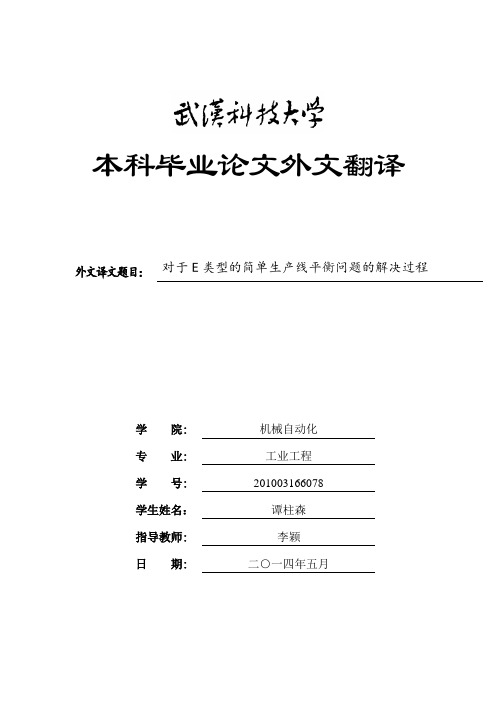
本科毕业论文外文翻译外文译文题目:对于E类型的简单生产线平衡问题的解决过程学院: 机械自动化专业: 工业工程学号: 201003166078学生姓名:谭柱森指导教师: 李颖日期: 二○一四年五月A solution procedure for type E simple assembly linebalancing problemNai—Chieh Wei , I-Ming ChaoIndustrial Engineering and Management,I—Shou University,No. 1,Section 1, Syuecheng Rd. Dashu District, KaohsiungCity 84001,Taiwan, ROC.对于E类型的简单生产线平衡问题的解决过程Nai-Chieh Wei , I-Ming Chao工业工程与管理,中华人民共和国,台湾省,高雄市,Syuecheng Rd。
Dashu街一号,义守大学,第一章第一节摘要本文提出了结合SALBP—1和SALBP-2的E型简单装配线平衡问题(SALBP—E),更多的,本研究为提出的模型提供了解决方法。
提出的模型在最小化空闲时间的同时优化装配线平衡率,为管理实践提供了更好的理解,计算结果表明:给出周期的上限ct以后,提出的模型可以最优的解决问题,因为它含有最少的变量,约max束和计算时间。
1前言从研究者第一次讨论装配线平衡问题以来,大约有50年了,在众多有关生产线平衡问题中,最基本的是简单装配线平衡问题,早在1954年,Bryton就定义并且研究了生产线平衡问题。
后一年,Salverson建立了第一个生产线平衡的数学模型并提出了定性的解决步骤,这引来了很大的兴趣,在Gutjahr 和Nemhauser说明生产线平衡是一种NP组合优化难题,大多数研究者希望开发一种能高效解决多种装配线问题的方法。
在随后的几年,生产线平衡成为了一个流行的主题,Kim,Kim,and Kim (1996)把生产线平衡分为五类问题,其中的问题1(SALBP —1)和问题Ⅱ(SALBP—Ⅱ)是两种基本的优化问题。
关于开题报告和外文翻译_注意事项
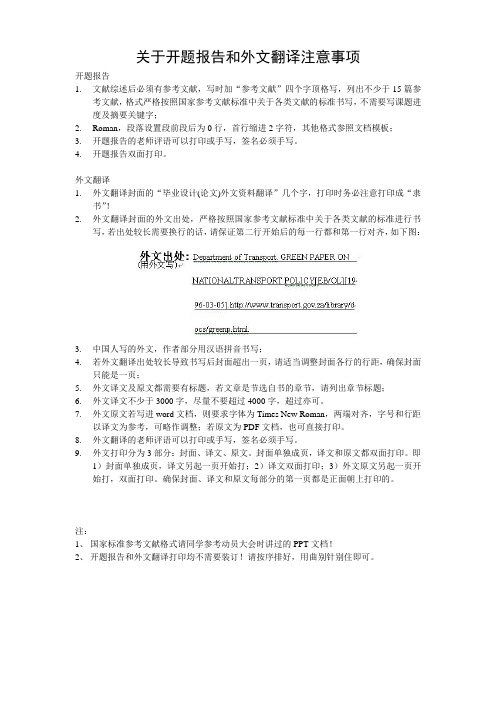
关于开题报告和外文翻译注意事项开题报告1.文献综述后必须有参考文献,写时加“参考文献”四个字顶格写,列出不少于15篇参考文献,格式严格按照国家参考文献标准中关于各类文献的标准书写,不需要写课题进度及摘要关键字;2.Roman,段落设置段前段后为0行,首行缩进2字符,其他格式参照文档模板;3.开题报告的老师评语可以打印或手写,签名必须手写。
4.开题报告双面打印。
外文翻译1.外文翻译封面的“毕业设计(论文)外文资料翻译”几个字,打印时务必注意打印成“隶书”!2.外文翻译封面的外文出处,严格按照国家参考文献标准中关于各类文献的标准进行书写,若出处较长需要换行的话,请保证第二行开始后的每一行都和第一行对齐,如下图:3.中国人写的外文,作者部分用汉语拼音书写;4.若外文翻译出处较长导致书写后封面超出一页,请适当调整封面各行的行距,确保封面只能是一页;5.外文译文及原文都需要有标题,若文章是节选自书的章节,请列出章节标题;6.外文译文不少于3000字,尽量不要超过4000字,超过亦可。
7.外文原文若写进word文档,则要求字体为Times New Roman,两端对齐,字号和行距以译文为参考,可略作调整;若原文为PDF文档,也可直接打印。
8.外文翻译的老师评语可以打印或手写,签名必须手写。
9.外文打印分为3部分:封面、译文、原文。
封面单独成页,译文和原文都双面打印。
即1)封面单独成页,译文另起一页开始打;2)译文双面打印;3)外文原文另起一页开始打,双面打印。
确保封面、译文和原文每部分的第一页都是正面朝上打印的。
注:1、国家标准参考文献格式请同学参考动员大会时讲过的PPT文档!2、开题报告和外文翻译打印均不需要装订!请按序排好,用曲别针别住即可。
文献翻译合同模板

文献翻译合同模板本合同由以下几方共同签署:翻译方(以下简称“翻译方”)和委托方(以下简称“委托方”),双方同意按照以下条款和条件进行翻译服务。
第一条任务描述1.1 翻译方将根据委托方提供的文件和指示,对指定的文献进行翻译工作,包括但不限于中英文之间的互译。
翻译方保证翻译的准确性和保密性。
1.2 翻译工作的完成时间将根据实际情况而定,双方应事先商定具体的交付时间。
第二条价格和支付方式2.1 委托方应按照翻译方提供的报价单支付翻译费用。
费用包括翻译费、排版费、校对费等,具体费用标准和支付细则可另行约定。
2.2 委托方需在签署本合同时支付部分翻译费用作为预付款,剩余费用需在翻译工作完成后一周内支付。
2.3 如因委托方原因导致翻译工作无法完成,委托方应支付已完成工作的费用。
第三条知识产权3.1 翻译完成后,翻译方将文献的翻译版权转让给委托方,委托方拥有翻译文献的使用权。
3.2 翻译方不得将翻译的文献用于其他商业用途,不得复制、传播或泄露给第三方。
第四条保密条款4.1 双方同意在翻译过程中保守文献的机密性,不得将文献内容透露给他人。
4.2 在翻译工作完成后,翻译方应销毁文献的一切副本,包括电子文件和纸质资料。
第五条违约责任5.1 若翻译方未按时完成工作或工作质量低下,委托方有权终止合同,要求返还已支付的费用。
5.2 若委托方未按时支付费用或违反合同其他条款,翻译方有权暂停工作,并有权要求委托方承担相应的违约责任。
第六条争议解决6.1 若因合同履行过程中发生争议,双方应友好协商解决。
协商不成的,可提请有管辖权的人民法院解决。
第七条其他事项7.1 本合同一式两份,翻译方和委托方各持一份,具有同等效力。
7.2 本合同自双方签署之日起生效,直至完成翻译任务并结清费用。
翻译方:委托方:签署日期:年月日。
- 1、下载文档前请自行甄别文档内容的完整性,平台不提供额外的编辑、内容补充、找答案等附加服务。
- 2、"仅部分预览"的文档,不可在线预览部分如存在完整性等问题,可反馈申请退款(可完整预览的文档不适用该条件!)。
- 3、如文档侵犯您的权益,请联系客服反馈,我们会尽快为您处理(人工客服工作时间:9:00-18:30)。
杭州电子科技大学
毕业论文外文文献翻译要求
根据《普通高等学校本科毕业设计(论文)指导》的内容,特对外文文献翻译提出以下要求:
一、翻译的外文文献可以是一篇,也可以是两篇,但总字符要求不少于1.5万(或翻译成中文后至少在3000字以上)。
二、翻译的外文文献应主要选自学术期刊、学术会议的文章、有关著作及其他相关材料,应与毕业论文(设计)主题相关,并作为外文参考文献列入毕业论文(设计)的参考文献。
并在每篇中文译文首页用“脚注”形式注明原文作者及出处,中文译文后应附外文原文。
脚注的方法:插入----引用---脚注和尾注
三、中文译文的基本撰写格式为:
1.题目:采用小三号、黑体字、居中打印;
2.正文:采用小四号、宋体字,行间距为固定值20磅,标准字符间距。
页边距为左3cm,右2.5cm,上下各2.5cm,页面统一采用A4纸。
英文原文如为word文档,请用罗马字体排版,段前空两格。
从正文开始编写页码,页码居中。
四、封面格式由学校统一制作(注:封面上的“翻译题目”指中文译文的题目),填充内容为加粗小三号楷体_GB2312,并按“封面、译文一、外文原文一、译文二、外文原文二、考核表”的顺序统一装订。
五、忌自行更改表格样式,学号请写完整。
封面和考核表均为一页纸张,勿换行换页。
毕业论文外文文献翻译
毕业设计(论文)题目Xxx
翻译(1)题目指翻译后的中文译文的题目翻译(2)题目指翻译后的中文译文的题目学院会计学院(以本模板为准)专业会计学(以本模板为准)姓名XXXXXX(以本模板为准)班级XX020811(以本模板为准)学号XX023101(以本模板为准)指导教师XXXXXX(以本模板为准)
外文翻译考核表。
